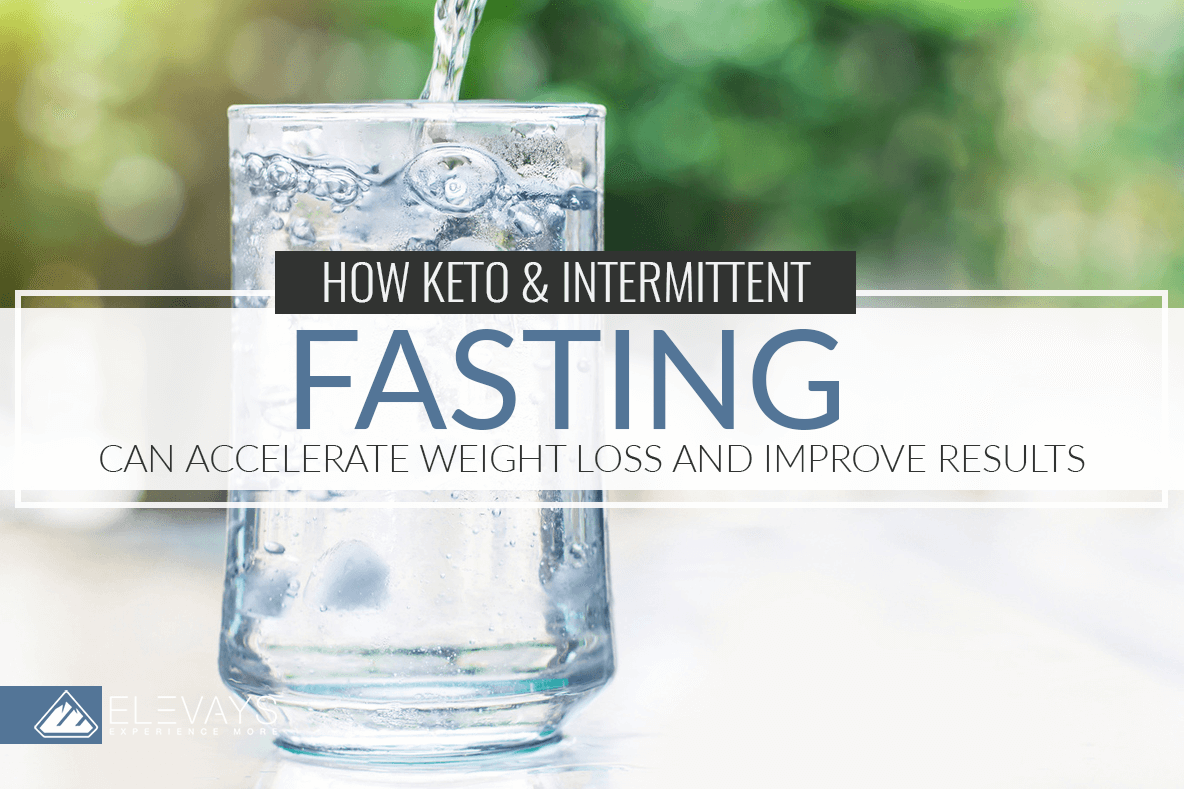What you eat and when you eat is a big topic of debate and there are lots of ideas about what the “right” diet is. While we can all probably agree on a goal of better health, it’s not always easy to differentiate between the voices advising you how to get there. So today I’d like to share the in’s and out’s of two popular diet plans that can support weight loss and health: keto and intermittent fasting.
First I’ll talk about what intermittent fasting and keto are, the benefits of the two diets and easy ways to incorporate them into your daily life. I’ll also get into how keto and intermittent fasting can support each other, followed up with anything to look out for when combining them.
So What is Intermittent Fasting?
Fasting can be a scary word, triggering that primal fear of where your next meal is coming from. But here’s the thing. Fasting is also a normal part of the human experience. Some people fast for religious purposes like Ramadan in the Muslim tradition (1), and most of us fast in some capacity every day: between dinner and breakfast.
TRUTH BOMB:
You’re
Already killing it!
If You Were More Consistent With Your Wellness Routine, You’d Be Unstoppable.
Besides that, most of your ancestors lived this way. Maybe they were nomadic, fasting while on the move and feasting when they reached a new destination. Or they were hunter-gatherers who didn’t have access to food storage, therefore holding out until they found their next meal (2).
My point is: the body has evolved to eat this way and can survive, even thrive, on fasting, rather than scheduling out 3-4 meals a day plus snacks. One 2016 study called “Fasting, Circadian Rhythms and Time Restricted Feeding in Healthy Lifespan” stated that this type of fasting can support us in using fat stores and ketones for energy, instead of sugar (3).
This is how keto and intermittent fasting support weight loss, as they teach your body to burn fat for energy, helping to melt away those extra pounds and use them for fuel!
Here Are a Few Ways to do Intermittent Fasting (1)
16/8 Fast
This is a really easy way to start practicing intermittent fasting. Basically it means eating for 8 hours a day and fasting for sixteen. Say you eat dinner around 7 p.m. then go to bed by 10 p.m. and skip breakfast the next morning. If you have your first meal at 11 a.m. you’ve done a 16 hour fast. To put it simply: eat an early dinner and skip breakfast!
The Warrior Diet
This is also similar to how our ancestors might’ve eaten. Basically consume only vegetables and some fruit during the day and have a big meal in the evening.
5:2 Diet
This is another simple method, just eat normally 5 days out of the week, and for the other 2 days, consume only 500-600 calories.
Eat-Stop-Eat
This is a next level kind of fasting schedule where you skip eating for a whole 24 hours. Say you eat dinner one night around 7 p.m. and then eat nothing until 7 p.m. the following day.
Intermittent fasting can be a sustainable way of eating for ultimate health and it doesn’t mean meditating in a cave or drinking nothing but water.
Note: I get frequently asked about juice fasts, but they are NOT something I would recommend for most people.
4 Benefits of Intermittent Fasting
-
Weight Loss
And this means fat loss, not muscle mass. Because you’re giving your body prolonged periods of rest between meals, it quickly uses up your glucose (sugar) stores and then requires other sources of energy, like fat. One 2015 study showed a decrease of anywhere between 3%-9% in body fat (4)!
-
Improved Memory
We all want better brain health, especially now that diseases like Parkinson’s and Alzheimer’s are becoming more common. One 2009 study found “a significant increase in verbal memory scores after caloric restriction” (5).
-
Heart Health
One of the bigger worries one might face today is bad cholesterol, leading to heart disease and potential strokes. A 2009 study showed a marked decrease in LDL cholesterol (the bad stuff) in only 8 days of alternate day fasting (6).
-
Regulates Blood Sugar
The other chronic illness plaguing so many people today is diabetes, which can cause blood sugar irregularity and low insulin. Again, because your body is getting less sugar for fuel and instead learning to thrive on fats, this type of fasting can stabilize blood sugar.
So now that we know a little bit about intermittent fasting and its health benefits, let’s tie it back to the ketogenic diet and how you can use fasting to induce ketosis.
What is Ketosis?
Well, I’m glad you asked. Ketosis is a state that happens when you consume a very low carb diet. It is a metabolic process where your body takes fat, converts it to ketones and uses that to fuel your body’s needs (7). That means your body eats up its own fat for fuel, instead of surviving off of stored sugars in the liver.
Getting into ketosis and staying there requires some planning and dedication, but the benefits can far outweigh the effort.
Weight Loss
Yep, the most popular reason to go on a diet. When the body uses fat for energy and enters ketosis, it begins to break down stored fat, especially around the mid-section! And that means stubborn belly fat. Energy from fat is more sustainable than carbs, leading to a more steady energy stream and lowered hunger cravings (8).
Blood Sugar Support
Besides the fact that a higher percentage of body fat increases your risk of diabetes, reducing sugar intake keeps blood sugar in check. Studies have shown that a ketogenic diet increases insulin sensitivity and can even help people lower their need for diabetes medication (9).
Heart Health
The ketogenic diet has been shown to lower bad cholesterol and increase good cholesterol, therefore supporting a healthy heart (9).
Mental Capacity
Patients with both Parkinson’s and Alzheimer’s have both showed improvement from a ketogenic diet (9).
Maybe you’ve already noticed some of the similarities between keto and intermittent fasting? And that’s because fasting to induce ketosis could be a great way to get more effective results from your ketogenic diet.
But What is the Ketogenic Diet?
Many people follow the ketogenic diet in order to get into ketosis, eating their normal three meals a day with some snacks. While I won’t go into all the in’s and out’s of the keto diet, here are seven of the big no’s when eating keto.
-
Sugar
No juices (even most vegetable juices are still full of sugar!). No ice cream, cake or soda. No healthy sugars like honey and agave.
-
Fruit
Remember healthy sugars? That means fruit too. Most fruits (except berries in moderation) are not keto approved.
-
Alcohol
Because alcohol is full of carbohydrates and often turns to sugar in the liver, it can easily take your body out of ketosis.
-
Starches
Even grains like wheat, rice, pasta, corn and granola.
-
Beans and Legumes
That’s right. No lentils, black beans, peas, chickpeas or soybeans.
-
Root Veggies
This means all potatoes, even sweet ones, and no carrots, beets and butternut squash.
-
Most Condiments
Have you checked the sugar content of most dressings and ketchup?
All of these food groups are excluded because they take the body out of ketosis and prevent you from getting the results you want to see. Since you’re making so much effort to achieve ketosis, don’t you want to do whatever you can to maximize your results? Fasting to induce ketosis is one way to support your efforts.
How do Keto and Intermittent Fasting Work Together?
Remember how I said that most of us go into mild ketosis without realizing it? Like going a while between eating dinner and breakfast. Well that’s a great way to induce ketosis, but as soon as you eat some form of carbs your body goes right back into its normal metabolic mode: using glycogen for fuel.
In order to get into ketosis faster and maintain the metabolic state you can be strategic about your fast and what you eat when you break it. One easy way to incorporate keto and intermittent fasting would be starting with the 16/8 plan. That would mean eating dinner around 7 p.m. and then not eating again until 11 a.m. the following day.
In order to do intermittent fasting keto style, when you break your fast choose ketogenic foods instead of carbs. Your body is already going into ketosis from all those hours of not eating and it will stay that way when you skip the carbs and instead choose high quality organic vegetables, fats and protein. Eat a regular ketogenic diet throughout the rest of your day, as much as you need to feel full.
Remember you are just choosing to fast for a certain amount of hours a day, so you won’t be counting calories. Going hungry is not the idea here! The goal is simply to train your body to use energy more efficiently by getting into ketosis and staying there.
Ready for some science behind why keto and intermittent fasting will help you build muscle and burn fat? You have a mechanism in your body called mTOR which increases the synthesis of protein in your muscles. Intermittent fasting is known to raise your body’s mTOR (10).
In fact, keto and intermittent fasting can be so effective together that children with epilepsy are often made to fast for 24-48 hours before being put onto a ketogenic diet to ease their seizures. This can help them get into ketosis and reduce seizures more quickly than diet alone (11).
If you really want to kickstart your fat burning – muscle building progress, you might try the eat-stop-eat method. This is not a healthy daily routine, but one day a week you could try the 23/1 intermittent fasting keto method, eating one big meal a day and skipping food until the next day around that time.
Other Ways To Support Keto and Intermittent Fasting
While intermittent fasting is one way to kickstart ketosis in your body and optimize your results on the keto diet, here are a few other ways.
-
Bulletproof Coffee
Dave Asprey, the man behind the bulletproof lifestyle and a dedicated biohacker, introduced bulletproof coffee as a way to optimize keto and intermittent fasting (10). Say you wake up after not eating anything for 12 hours. You’re hungry but you’re fasting for another few hours and need a boost to get through the day, try a bulletproof coffee.
Recipe for Bulletproof Coffee
- Start with a french press, which doesn’t filter out the beneficial oils from coffee. Add 2 ½ heaping tablespoons of ground bulletproof coffee beans (these are specially sourced beans that do not contain the mycotoxins usually found in coffee).
- Add 8-12 oz of boiled water and allow it to sit until it reaches the desired strength.
- Add 1 teaspoon (gradually increasing up to 2 tablespoons) of brain octane oil, a purified type of MCT oil derived from coconut oil.
- Add 1-2 tablespoons of unsalted grass-fed butter or ghee (depending on your sensitivity to dairy).
- Blend all of these ingredients in a high-powered blender until it looks as creamy and frothy as a latte and ejoy!
Why is bulletproof coffee a good breakfast replacement?
- The high quality fats from the butter are full of omega-threes and other fat-soluble vitamins like A, D, E and K. It will give your body fuel because it is already in ketosis mode. It is also keto and intermittent fasting friendly!
- Caffeine gives you a boost and can help stave off hunger. The fats will also help the caffeine release more slowly into your body as opposed to an instant rush. This supports a more long lasting energy.
- The MCT oil will go straight to the liver where it’s converted to ketones: aka instant energy and is great for inducing ketosis (7).
-
Exercise
While you may be able to see results from keto and intermittent fasting alone, boosting your physical activity is a great way to get optimal results from being in ketosis. Exercising while fasting increases blood ketone levels which then becomes the fuel for your workout. In fact, one 2014 study showed that being in ketosis may actually support greater physical endurance (13).
This means that by combining keto and intermittent fasting with exercise, your endurance could improve and you could burn fat and build more muscle while you’re at it (remember the mTOR process?)
Who isn’t looking for a way to optimize a workout?
-
Fat Fasting
If you’re struggling to maintain keto and intermittent fasting you could also try a temporary fat fast. This is another way to get into ketosis more quickly and includes eating about 1,000 calories a day, with anywhere from 85%-90% of those calories being from fat.
It is only recommended to try this for 3-5 days, as the lack of protein and calories are not ideal over time. This however, could be a way to get your body into ketosis as you slowly adjust to trying keto and intermittent fasting (7).
-
Protein
Epilepsy patients and others using a strict ketogenic diet for health reasons often cut way back on both carbs and protein. But that’s not ideal for the average person focusing on health and fat loss.
By practicing keto and intermittent fasting together, you’re already encouraging your body to get into ketosis more quickly. But you don’t need to go overboard. Eating just enough protein helps your liver get all the amino acids it needs to make new glucose. This way, the cells in your body that can’t use ketones will still get the fuel they need to function (7).
And then there is the issue of muscle. You are working so hard getting into ketosis and working out to lose fat, you don’t want to lose muscle too!
Fasting Schedule Example
Here is an example of what a day of intermittent fasting and keto could look like that includes some of the other ketosis boosting practices!
7 a.m. Drink a cup of bulletproof coffee after waking up.
9 a.m. Get to the gym for a workout that includes strength training.
11 a.m. Yep it’s already time to eat! Go for a breakfast meal like a vegetable omelette with avocado.
2 p.m. Try chicken salad rolled in lettuce leaves for lunch.
Snack Eat some celery with macadamia nut or almond butter
7 p.m. Take time to slowly enjoy some baked salmon with asparagus or broccoli.
See? Keto and intermittent fasting are not so hard to do. But find your own way to incorporate the two practices and take it slow.
You might want to start with a fat fast for a few days, just to get your body into ketosis more quickly. Then you could spend a week eating whenever you want, following the ketogenic diet and learning some new keto-friendly recipes. Once you’re comfortable with that, try doing keto and intermittent fasting together. There is no one size fits all approach, so find a routine that works for your body.
So by now you may be totally on board with trying keto and intermittent fasting, but keep in mind, nothing is perfect and there are some things to watch out for.
Are Keto and Intermittent Fasting Safe?
People with both type 1 and type 2 diabetes have found great results with keto. But they may need to be more mindful of their blood sugar levels, especially when trying keto and intermittent fasting together with shots of insulin. Talking to your doctor about how to modify insulin doses on keto should help you find balance.
Here’s the deal. Many people find an increase in insulin sensitivity after adjusting to keto, leading to more stable blood sugar levels and less dependence on insulin over time.
However, there are some people who could have the opposite reaction and experience increased insulin resistance. In this case they would need more insulin for even a little bit of carbs (14).
Doctors recommend testing blood sugar levels throughout the day if you are diabetic and on a ketogenic diet. Test, don’t guess, isn’t that the saying? What you don’t want when trying keto and intermittent fasting is to allow your blood sugar to get too low when taking a normal dose of insulin (15).
Signs that your blood sugar is too low (16)
- Confusion and dizziness
- Shaking or anxiety
- Irritability and sweating
- Fast pulse or heart palpitations
- Feeling faint
Drinking a bit of juice or eating a spoonful of honey could help your blood sugar come back into balance. It may or may not take you of out ketosis, but the point is not to pass out! If blood sugar gets lower than 70 mg/ dl, it could be dangerous.
Women who are pregnant or breastfeeding should use caution when trying any new diet, especially one that restricts carbs or calories. The body is already working double time and a restrictive diet could cause a state of stress.
Another consideration is for women who already have very low body fat or struggle with menstrual irregularities. In these cases, keto and intermittent fasting could cause hormonal imbalances to occur.
In Conclusion
Basically ketosis is a metabolic state that can support weight loss, increase endurance, build muscle and support stable blood sugar. For most people the keto diet and intermittent fasting are not going to cause any issues. But if you’re dealing with a chronic condition it’s always a good idea to check with your health care provider before diving headfirst into the keto and intermittent fasting lifestyle.
Also, everyone’s body is different and some people get into ketosis faster and more easily than others. Monitor your progress by testing ketone levels and adjust your diet as needed to stay in a healthy state of equilibrium. A ketonix meter can measure the levels of acetone in your breath. This will confirm that you are in ketosis and make sure your levels aren’t too high (7).
Now, I’d love to hear from you. Have you tried keto and intermittent fasting? What kind of results have you found from combining them? Do you have any stories to share? Leave a comment below!
Sources:
- Dr. Axe (2018). Intermittent Fasting Benefits: Lose Weight, Protect the Heart and Brain, and More. Retrieved from: https://draxe.com/intermittent-fasting-benefits/
- Healthline (2018). Intermittent Fasting 101: The Ultimate Beginner’s Guide. Retrieved from: https://www.healthline.com/nutrition/intermittent-fasting-guide
- Longo, V. D., & Panda, S. (2016). Fasting, circadian rhythms, and time-restricted feeding in healthy lifespan. Cell metabolism, 23(6), 1048-1059. Retrieved from: https://www.ncbi.nlm.nih.gov/pmc/articles/PMC5388543/
- Tinsley, G.M. (2015). Effects of Intermittent Fasting on Body Composition and Clinical Health Markers in Humans. Nutr Rev. 2015 Oct;73(10):661-74. Retrieved from: https://www.ncbi.nlm.nih.gov/pubmed/26374764
- Witte, A. V., Fobker, M., Gellner, R., Knecht, S., & Flöel, A. (2009). Caloric restriction improves memory in elderly humans. Proceedings of the National Academy of Sciences, 106(4), 1255-1260. Retrieved from: http://www.pnas.org/content/106/4/1255
- Varady, K. A., Bhutani, S., Church, E. C., & Klempel, M. C. (2009). Short-term modified alternate-day fasting: a novel dietary strategy for weight loss and cardioprotection in obese adults–. The American journal of clinical nutrition, 90(5), 1138-1143. Retrieved from: https://www.ncbi.nlm.nih.gov/pubmed/19793855
- Healthline (2016). 7 Tips to Get Into Ketosis. Retrieved from: https://www.healthline.com/nutrition/7-tips-to-get-into-ketosis
- Everyday Health (2018). Benefits and Risks of the Keto Diet Everyone Should Know. Retrieved from: https://www.everydayhealth.com/diet-nutrition/ketogenic-diet/what-are-benefits-risks-keto-diet/
- Healthline (2018). The Ketogenic Diet: A Beginner’s Guide to Keto. Retrieved from: https://www.healthline.com/nutrition/ketogenic-diet-101.
- Asprey, Dave, (2018). Bulletproof Intermittent Fasting: Lose Fat, Build Muscle, Stay Focused & Feel Great. Retrieved from: https://blog.bulletproof.com/bulletproof-fasting/
- Kossoff, E. H., Laux, L. C., Blackford, R., Morrison, P. F., Pyzik, P. L., Hamdy, R. M., … & Nordli, D. R. (2008). When do seizures usually improve with the ketogenic diet?. Epilepsia, 49(2), 329-333. Retrieved from: https://www.ncbi.nlm.nih.gov/pubmed/18028405
- Asprey, Dave (2016). How to Make Bulletproof Coffee and Make Your Morning Bulletproof: Retrieved from: https://blog.bulletproof.com/how-to-make-your-coffee-bulletproof-and-your-morning-
- Cox, P.J. and Clarke, K. (2014). Acute nutritional ketosis: implications for exercise performance and metabolism. Extrem Physiol Med. 2014 Oct 29;3:17. doi: 10.1186/2046-7648-3-17. eCollection. Retrieved from: https://www.ncbi.nlm.nih.gov/pubmed/25379174
- Diabetes Strong ( 2018). The Ketogenic Diet and Diabetes: The Definitive Guide. Retrieved from: https://diabetesstrong.com/ketogenic-diet-and-diabetes/
- Healthline (2017). How the ketogenic diet works for type 2 diabetes. Retrieved from: https://www.healthline.com/health/type-2-diabetes-ketogenic-diet#effects
- WebMD (2018). Hypoglycemia: when your blood sugar gets too low. Retrieved from: https://www.webmd.com/diabetes/guide/diabetes-hypoglycemia#1









I am currently on the 16/8 IF Schedule, this article helped me get started https://blog.piquetea.com/beginners-guide-to-intermittent-fasting/ and continues to be my guide. Can I start keto anytime while doing IF? I am worried because we have a family history of diabetes.
Keto and intermittent fasting can go hand in hand without issue for most, but we always recommend speaking with your doctor before making any major changes! Especially if you have major health issues that are of concern, like diabetes.
This is really good information, Dr. Jones. I am trying the 16/8 IF and after a week starting to notice its having an effect. I’ve also read the report at https://www.ketowiz.com/keto-and-intermittent-fasting/ and I noticed they talk about something called autophagy. Do you know if this autophagy happens on the 16/8 intermittent fast?